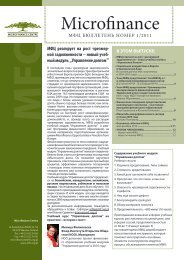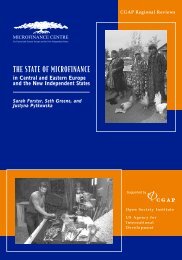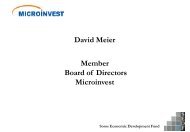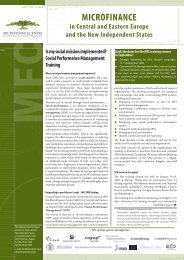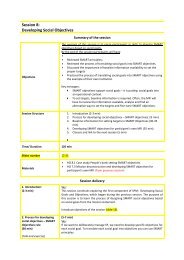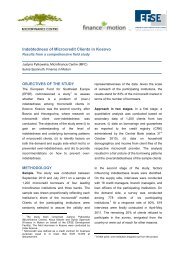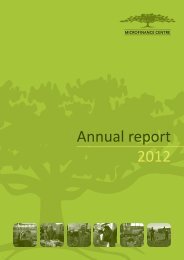Value Chains research report Tajikistan final - Microfinance Centre
Value Chains research report Tajikistan final - Microfinance Centre
Value Chains research report Tajikistan final - Microfinance Centre
Create successful ePaper yourself
Turn your PDF publications into a flip-book with our unique Google optimized e-Paper software.
Domestic market for honey.<br />
The production of honey in <strong>Tajikistan</strong> is mostly aimed at meeting the needs of the<br />
local consumers at the domestic market. The current demand for honey in <strong>Tajikistan</strong> is<br />
moderate, in our opinion. Traditionally, honey consumption in <strong>Tajikistan</strong> is associated<br />
primarily with medicinal purposes, rather than nutritional value, and this explains the low unit<br />
consumption levels.<br />
According to the information on honey prices in the country’s markets, in the last two<br />
years the prices increased by 20% 23 . The price of honey today is varied between 20 and 30<br />
Somoni per kilogram, or $4.20-6.20. However, analysis of supply at the markets has shown<br />
that prices can vary by as much as 100%, depending on the quality and variety of the<br />
product. It is obvious; however, that cost of production does not allow selling any cheaper<br />
than the prices indicated above. It is economically reasonable that higher yield per bee<br />
family means cheaper prices, since higher output means lower fixed cost per unit of product<br />
sold.<br />
Results of <strong>research</strong> at the domestic market for honey in <strong>Tajikistan</strong> have shown that<br />
the distribution system for honey and its secondary products is chaotic and random. Each<br />
beekeeper sells his/her product in whatever way they find more comfortable: some sell<br />
directly at the markets, some distribute their honey for consignation, others distribute honey<br />
through acquaintances.<br />
When the local people buy honey for consumption purposes, they look for the<br />
cheapest product. More often than not, cheap honey results from feeding the bees with<br />
sugar syrup, not from processing pollen. Another substitute is fake honey – a mixture of<br />
honey and boiled sugar, which is sold under the name of “artificial honey”, or “shini”.<br />
23 www.agroinform.tj<br />
112




